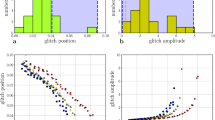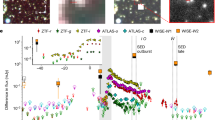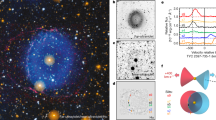Abstract
Various theories have been proposed to account for the origin1,2 of the low surface brightness features resembling thin shells seen in projection around some otherwise normal elliptical galaxies3. It has proved impossible to discriminate between these models owing to the lack of quantitative data on the nature of the shells. Here we present broad-band optical (B, V, R) and near-IR (J, H) photometry of one of the shells to determine their constitution and place constraints on their mode of formation. The colour indices derived suggest that the shell comprises a population of stars, perhaps bluer than the main body of the galaxy. There is no evidence for recent star formation. Our results favour dynamical models for the formation of the shells, perhaps from recent mergers of disk galaxies with the elliptical.
This is a preview of subscription content, access via your institution
Access options
Similar content being viewed by others
References
Fabian, A. C., Nulsen, P. E. J. & Stewart, G. C. Nature 287, 613 (1980).
Quinn, P. J. Astrophys. J. Lett. (in the press).
Malin, D. F. & Carter, D. Nature 285, 643 (1980).
Walker, M. F. Mon. Not. R. astr. Soc. 186, 767 (1979).
Bessell, M. S. Publ. astr. Soc. Pacif. 91, 589 (1979).
Barton, J. R. & Allen, D. A. Publ. astr. Soc. Pacif. 92, 368 (1980).
Persson, S. E., Frogen, J. A. & Aaronson, M. Astrophys. J. Suppl. 39, 61 (1979).
Frogel, J. A., Persson, S. E., Aaronson, M. & Matthews, K. Astrophys.J. 220, 75 (1978)
Author information
Authors and Affiliations
Rights and permissions
About this article
Cite this article
Carter, D., Allen, D. & Malin, D. Nature of the shells of NGC1344. Nature 295, 126–128 (1982). https://doi.org/10.1038/295126a0
Received:
Accepted:
Issue date:
DOI: https://doi.org/10.1038/295126a0
This article is cited by
-
Astrophysics: Galaxies in collision
Nature (1984)



